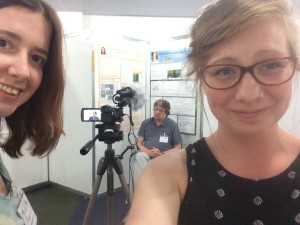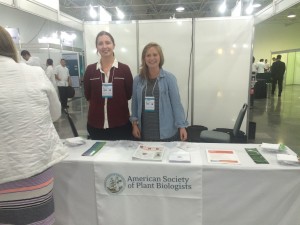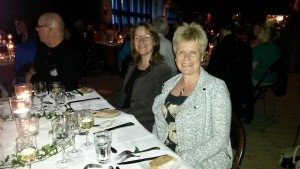
Celia Knight and Saijaliisa Kangasjarvi at the conference dinner
The 26th Scandanavian Plant Physiology Society (SPPS) Congress took place from the 9th – 13th August at Stockholm University. Celia Knight attended the meeting and has written a report for the blog this week, so that those of you who couldn’t attend are up to speed!
A diversity of speakers and topics
Attending SPPS 2015 was a fantastic opportunity to hear about progress across a really broad spectrum of plant biology research. The program included sessions on development, epigenetics and gene regulations, high-throughput biology, photobiology, abiotic stress, education and outreach, and biotic interactions. There really was something for everyone! Additionally, the organizers had made a notable effort to include a good mix of both established and early career researchers, further adding to the diversity of talks on offer.
I was struck by the contributions from the various Society awards so will focus on these.

Beautiful Stockholm where the meeting was held
SPPS awards
Gunnar Öquist (Umeå University, Sweden) was given the SPPS Award in recognition of his outstanding merited contribution to the science of plant biology. His talk entitled “My view of how to foster more transformative research” provided a reminder that the dual aims of research, both to solve problems and to seek new knowledge, are very important if global challenges are to be met.
The SPPS early career award recognizes a highly talented scientist who has made a significant contribution to Scandinavian plant biology. This year two early career awards were given. The first recipient, Ari-Pekka Mähönen (University of Helsinki, Finland), received the award for his work on growth dynamics in Arabidopsis thaliana, and showed some amazing sections to follow cambium development. Nathaniel Street (Umeå University, Sweden) also received an award for his work “Applying next generation sequencing to genomic studies of Aspen species and Norway Spruce”. Both gave great talks including strong research in these areas; it was great to see upcoming researchers take the spotlight and give us a glimpse to the future of plant biology.
Torgny Näsholm (SLU, Umeå Sweden) was awarded the Physiologia Plantarum award. This award is given to a scientist that has made significant contribution to the areas of plant science covered by the journal Physiologia Plantarum. Torgny uses microdialysis, a technique currently used by neuroscientists, to investigate the availability of soil nitrogen to plants. Data generated using this technique are now bringing into question our current view of nitrogen availability measured using traditional methods.
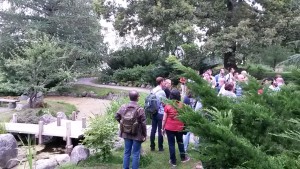
Additional activities included a tour of the Bergius Botanic Garden
The Popularisation prize, awarded to Stefan Jansson (Umeå University, Sweden), recognizes significant contributions to science communication and public engagement. Stefan’s work in public engagement has been wide-ranging. He has been involved with The Autumn Experiment, a citizen science project engaging schools in observation, data collection and real research. Recently Stefan published a book in Sweden, called ‘GMO’, which tackles the response of societies to genetically modified organisms.
At the congress, Stefan took over as the new President of the SPPS. This could lead to further emphasis and resources being placed on communicating science as the society moves forward.
Poster prizes
Prizes for the best posters are also awarded at the meeting. Five judges, including myself, assessed the posters, and the competition was fierce. It was impossible to split the top prize, so joint 1st prizes were awarded to Veli Vural Uslu (Heidelberg University, Germany) on “Elucidating early steps of sulfate sensing mechanisms by biosensors” and to Timo Engelsdorf (Norwegian University of Science and Technology, Norway) for “Plant cell wall integrity is maintained through cooperation of different sensing mechanisms”. Joint second prizes went to Zsofia Stangl (Umeå University, Sweden) on “Nutrient requirement of growth in different thermal environments” and to Annika Karusion (University of Tartu, Estonia) for “Circadian patterns of hydraulic and xylem sap properties: in situ study on hybrid aspen.”
Additional activities
Like any meeting, SPPS wasn’t all work and no play! Lisbeth Jonsson (Stockholm University, Sweden) and her team organized an excellent program. I feel very fortunate, on this short trip, to have had the opportunity to view Stockholm’s fine City Hall where Nobel laureates have dined, as well as the incredibly preserved Vasa ship, which sank in Stockholm bay on its maiden voyage in 1628.
I very much look forward to seeing how the society progresses in the future, and nurturing new friendships and collaborations I made at the congress.
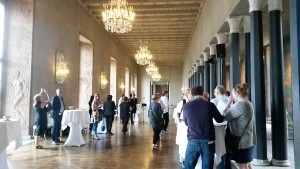
The Drinks reception at the City Hall, walking in the footsteps of Nobel Laureates




